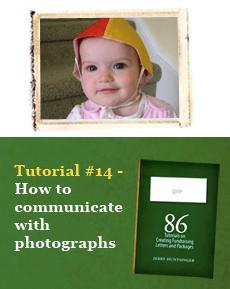Tutorial 14: How to communicate with photographs
If ‘a picture is worth a thousand words’ why do nonprofits persist in creating appeals with 2,000 words, or more, with no pictures?
- Written by
- Jerry Huntsinger
- Added
- February 15, 2019

Photography is a moment of life captured in the act. It’s a slice of time; it’s now. Check out your favourite magazine. What do you see on the cover? A photograph, or a logo?
Flip through the heart of the magazine. You’ll see headlines, photographs and subheads and a few words.
Instructions to your photographer
Avoid:
- Buildings.
- Group scenes.
- Long shots.
- Sexy teenagers.
- Open sores.
- Deformed limbs.
- Men with moustaches.
- People who are overweight.
- A person in an airport waving goodbye.
- A board of directors assembled for a meeting.
- Administrators administrating.
But you can show your staff in action: a doctor, a nurse, or a social worker. Then, if possible, show your staff in close contact with a child or a teenager, or an adult or individual who represents the focus of your organisation’s mission.
This is the most difficult type of photography imaginable: capturing the essence of an organisation through a photograph. So tell your photographer to take lots of shots. It’s a percentage game, if you take enough pictures something good will happen eventually.
Eye movement and images
Your photographer needs to understand eye movement in relation to layout. When a reader picks up a piece of mail, the eyes drift rapidly clockwise because of our left to right reading habits. And these movements form a horizontal, oblong pattern because vertical eye movement is tiring.
Got that? No, I’m not describing drug addiction. Your eyes make a series of oblong trips around the page, moving with incredible speed. Why? Because they are searching for a place to stop. And when the eye stops, a message goes to your brain that says, ‘Here’s something very important.’
Your eye comes to rest on a photograph before it comes to rest on a piece of artwork or a logo. And it’s most likely to come to rest directly on the eyes of the person in the photograph. Humans are social animals. They communicate in a positive way by looking at another person’s eyes, or in a negative way by refusing to make eye contact. However, we don’t want to be too intimate. We all have a privacy zone that we don’t want anyone to penetrate – at least not a stranger. So, if you take a picture of a person and get too close up with too many details, it can be dangerous.
More irony: we don’t like to communicate with unattractive people. Think that over because it’s very important – and sad, but true. That’s why the picture of an attractive child with a clean face in a poverty setting will usually do better than the picture of an unattractive child with a filthy face in a poverty setting. Too much negative reality in photographs can drive the reader away.
Photographs and layout
If your artist is not experienced in direct response marketing, then you and your artist will probably end up bitter enemies.
Artists love to ruin your photographs. That is, if you can get them to use a photograph. They forget that the only function of art in a marketing context is to provide a layout that helps headlines and pictures work together, so that the eye is immediately involved.
And for goodness sakes, don’t let your artist turn a photograph into art. I see many perfectly good photographs where the artist has cut the picture out of the background, leaving the silhouette of the individual. Artists like to do this, they have a silhouette complex. They are artists but, for them to work effectively in your situation, they have to become layout artists. On the other hand, don’t be afraid to crop irrelevant details from the picture in order to achieve the focal point.
Almost never let your artist choose the picture, that’s your job as the creator of the package. You have to decide on the facts and the emotion to be conveyed by the photograph. The artist can help you crop the picture and keep the picture in balance and provide a good layout.
Marketing secret number 427
Use a caption under the photograph. This is a little technique that is remarkably effective. Here’s why: as long as the reader is looking at the photograph, his mind is in your controlling hands.
You want him to go from picture to words. And the place to begin that journey is with the words right under the picture. If he gets trapped with the picture, then his eyes drift down to the description line. Suddenly, without any conscious effort, he is reading words.
For those brief seconds you have the reader. When he picked up your letter, he was thinking about a dozen other things, but now you’ve successfully hooked him. You’ve moved him from being a scanner to a word reader. And do you know what he’s most apt to do next? Yes, read some more words in your letter. Of course, you don’t know what words he’s going to read because his eyes may jump to a headline or to an underlined sentence or phrase. And he’ll go through the scanning process and most likely even quickly turn the page over and see what is on the other side. Then, if you are lucky, he’ll come back and start with the headline and read the first sentence of your copy.
Marketing secret number 135
If you come up with some good photographs, don’t waste them by putting them in a brochure. Instead, put them on the letter. Brochures test out poorly; in fact, often they both depress results and add cost to the package. But a photograph on a letter does not increase the cost of the package and usually enhances results.
Marketing secret number 183
If you have a really great photograph, use it the same way that you might use a logo and put it on the carrier, the reply device, the letterhead and enclosures. It gives your package intensity and ties it all together.
© SOFII Foundation 2010-2014.


















